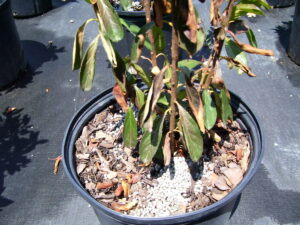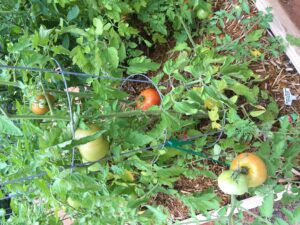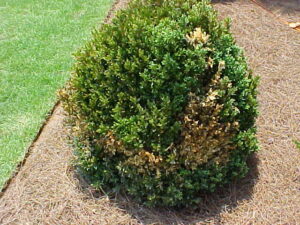Plant Health Alert – Plant Problems Related to Excessive Rain
go.ncsu.edu/readext?810387
en Español / em Português
El inglés es el idioma de control de esta página. En la medida en que haya algún conflicto entre la traducción al inglés y la traducción, el inglés prevalece.
Al hacer clic en el enlace de traducción se activa un servicio de traducción gratuito para convertir la página al español. Al igual que con cualquier traducción por Internet, la conversión no es sensible al contexto y puede que no traduzca el texto en su significado original. NC State Extension no garantiza la exactitud del texto traducido. Por favor, tenga en cuenta que algunas aplicaciones y/o servicios pueden no funcionar como se espera cuando se traducen.
Português
Inglês é o idioma de controle desta página. Na medida que haja algum conflito entre o texto original em Inglês e a tradução, o Inglês prevalece.
Ao clicar no link de tradução, um serviço gratuito de tradução será ativado para converter a página para o Português. Como em qualquer tradução pela internet, a conversão não é sensivel ao contexto e pode não ocorrer a tradução para o significado orginal. O serviço de Extensão da Carolina do Norte (NC State Extension) não garante a exatidão do texto traduzido. Por favor, observe que algumas funções ou serviços podem não funcionar como esperado após a tradução.
English
English is the controlling language of this page. To the extent there is any conflict between the English text and the translation, English controls.
Clicking on the translation link activates a free translation service to convert the page to Spanish. As with any Internet translation, the conversion is not context-sensitive and may not translate the text to its original meaning. NC State Extension does not guarantee the accuracy of the translated text. Please note that some applications and/or services may not function as expected when translated.
Collapse ▲This summer has been wet and that is taking its toll on some of our landscape plants. The N.C. Cooperative Extension, Henderson County Center team has fielded numerous calls from homeowners, many of them asking the same few questions: “Why is my plant dying,” or “Why is my tree dropping its leaves?” or “Why are my leaves curling?”
The effects of flooding on plants are numerous, but there are a few that seem to occur more often than the others. Excess rain recently has increased plant disease. Root-rotting fungi are endemic in soil, usually living on decaying organic matter. But, if the soil conditions become favorable for the fungi (cool and wet), they can begin to overcome weakened, water-stressed plants.
These fungi nibble on root hairs and root tips where plants take up water and nutrients and in severe cases move into the aerial parts of the plant. So, even if the soil is saturated, the plant may still get too little water and nutrients. Symptoms may not be visible until the temperatures rise and plants begin to need water. Then, the plants seem as if they are not getting enough water and begin to wilt or drop their leaves.
 Plants naturally keep a balanced amount of roots and shoots. This ratio of roots to shoots must be maintained. When a plant loses roots, it must compensate for the loss by losing leaves.
Plants naturally keep a balanced amount of roots and shoots. This ratio of roots to shoots must be maintained. When a plant loses roots, it must compensate for the loss by losing leaves.
Trees may drop their leaves for other rain related reasons as well. Fungi can colonize leaves and cause leaf spots during times of high humidity. These pests extract the nutrients out of leaves turning them yellow then brown. Finally, the leaves fall to the ground. Plants may drop leaves that are infected to preserve the rest of the plant. Usually, leaf spot diseases are not too damaging to plants.
Flooded soils induce nutrient deficiencies in plants. Nutrients are leached out of the soil and roots cannot uptake nutrients due to the lack of root tips and hairs. Plants begin to lose their vigor, growing more slowly than they should and this also reduces nutrient uptake from the soil. Nutrient starved plants begin to look unhealthy with leaves that fade from dark green to yellow. Plants then become weak. Nutrient deficiencies may be seen as leaf yellowing, purpling, or cupping.
 Leaf curl is another symptom of flooding stress. Leaves curl due to increased amounts of plant growth hormones that are produced by the plant in response to stress. Ethylene, a gas released in response to stress, causes leaf curl. It seems herbaceous plants such as tomatoes are more apt to show this type of symptom than woody trees. This condition will abate if the soil conditions improve.
Leaf curl is another symptom of flooding stress. Leaves curl due to increased amounts of plant growth hormones that are produced by the plant in response to stress. Ethylene, a gas released in response to stress, causes leaf curl. It seems herbaceous plants such as tomatoes are more apt to show this type of symptom than woody trees. This condition will abate if the soil conditions improve.
There isn’t much one can do to stop the rain. But, there are some things that we as gardeners can do to improve our plants’ chances of survival during wet weather:
- Firstly, pull back the mulch around stressed out plants. Expose the soil allowing evaporation to remove some of the soil water.
- Decrease shade by removing any low hanging branches of surrounding trees. This will allow the sun to stimulate the plant to grow.
- Increase air circulation in and around plants by selective pruning to open up plants and plantings to fresh air and light.
- Fertilize landscape plants that appear to need it lightly with water soluble fertilizer .
- Remove dead leaves and limbs from landscape plants and rake beneath the plants. Removing diseased tissue from the plant itself and from beneath it decreases the amount of fungus that could reinfect the plant.
- In areas with saturated soil, raising planting beds and planting moisture tolerant species are the best and easiest things a home gardener can do utilize wet areas.






